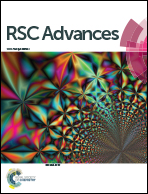Sensitive fluorescent detection of fibrin based on the inner filter effect of gold nanoparticles†
Abstract
A simple, rapid and sensitive fluorescent assay for determination of fibrin has been developed based on the inner filter effect (IFE) of gold nanoparticles (AuNPs). When fibrinogen (Fib), as the precursor of fibrin, was added into the AuNPs solution, the fluorescence of fluorescein was very weak due to the intensive absorption of AuNPs. In the presence of thrombin, Fib was transformed to fibrin which interacted with AuNPs, thereby inducing the aggregation of AuNPs, which induced the recovery of fluorescence. As a result, the present IFE-based approach can detect fibrin ranging from 0.125–2.5 nM with a correlation of 0.9926. The limit of detection for fibrin was experimentally determined to be 40 pM, based on a signal-to-noise ratio (S/N) of 3. Notably, the present IFE-based approach had advantages of being simple, time-saving, and economical compared with conventional fluorescent assays. The method is successfully applied to the quantification of fibrin in human plasma samples.



 Please wait while we load your content...
Please wait while we load your content...